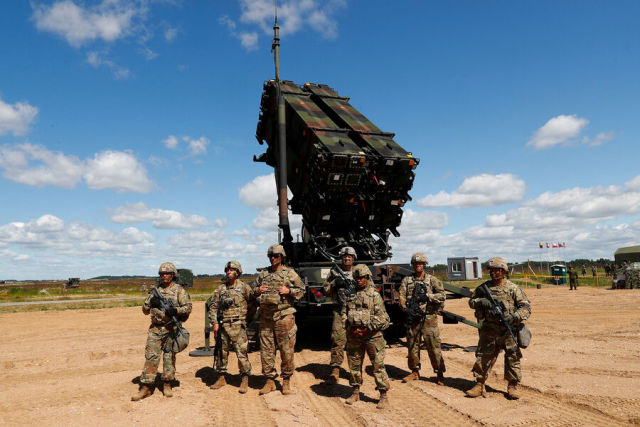The Patriot anti-aircraft missile system has flaws, but not the ones found in Forbes Forbes journalist Paul Iddon called low mobility a weak point of the Patriot air defense system.
Why this cannot be called a minus and what vulnerabilities the American complex actually has, says the military observer of the newspaper.En" Mikhail Khodarenok in his column.
Forbes columnist Paul Iddon called the main vulnerability of Patriot anti-aircraft missile systems to the means of air attack of the Russian Aerospace Forces. According to him, the weak point of the American anti-aircraft missile system is low mobility, which the Russian military will be able to take advantage of.
Paul Iddon explained that only three specialists are required to "maintain" one battery, while up to 90 people are required to "move and configure all components".
However, the time of folding/deployment of the Patriot anti-aircraft missile system material (25 minutes) it is not a particularly critical indicator for the combat use of medium/long-range air defense systems. All Patriot equipment (multifunctional radar, combat control point, launchers, power supply and communication facilities) are mounted on motorhomes and trailers, and the transfer from the combat position to the marching position (and vice versa) takes a fairly short period of time.
For example, in the recent incident with the fall of the S-300PT anti-aircraft guided missile in Poland, units of the 540th anti-aircraft Missile Regiment of the Air Forces of Ukraine, stationed on the cover of Lviv, took part. The 540th ZRP received equipment back in Soviet times, and the S-300PT anti-aircraft missile system, which is equipped with this part, is the very first, still container version of the S-300.
As the newspaper wrote earlier .Ru", the weight of some containers (in particular, the command post of the F9 system) is 16 tons, and not every truck crane can lift them for subsequent loading onto a trailer. In other words, the time of folding and deployment of the material part of the S-300PT 540th ZRP is several hours.
Among other things, the Forbes journalist noted that the APU is unlikely to use the Patriot air defense system to counter unmanned aerial vehicles, since a large number of UAVs can "penetrate air defense means."
The fact is that the APU is likely to receive one Patriot anti-aircraft missile battery. Most likely, the battery will be deployed to cover Kiev (the government quarter in the first place) from the attacks of cruise missiles of various types of basing (sea and air) and tactical (operational-tactical) ballistic missiles.
In other words, Patriot has, as the military says, the potential of non-strategic missile defense, and this quality will especially help the Armed Forces. It is impractical to carry out live firing from Patriot air defense systems at small-sized and inexpensive unmanned aerial vehicles. First of all, it is a means of combating manned aviation, KRMB and KRVB, TBR and OTB.
Now about the words of Paul Iddon that only three specialists are required to "maintain" one battery, while up to 90 people are required to "move and configure all components".
To begin with, we note that the staff of any anti-aircraft missile unit (battery or division) is made up of the calculation of ensuring the functioning of two full combat crews. And this is data of a secret nature. All considerations regarding the "three specialists" and "90 people" can be attributed solely to the assumptions of the journalist and his personal opinions on this issue.
But there are no extra people intended exclusively for "moving and configuring all components" in the staff of the Patriot anti-aircraft missile battery (as well as any other anti-aircraft missile unit of any armed forces). "Moving" in the military language is called transferring the material part from the combat to the marching position and making a march, and "setting up all components" is called routine maintenance and maintenance of one or another periodicity.
The publication Politico reports that the Pentagon is considering the possibility of retraining the combat crews of the anti-aircraft missile forces of the Armed Forces of Ukraine on the Patriot air defense system at a military base in the United States of America. Anti-aircraft missile weapons of the Armed Forces of Ukraine will not be transferred until the end of the retraining period, sources in the US Department of Defense say.
And finally, what weaknesses does the Patriot air defense system actually have. More precisely, I must say not weaknesses, but features. The fact is that the Patriot AN/MPQ-53 multifunctional radar has relatively low search capabilities. And this feature is inherent not only in the Patriot air defense system, but also in the Russian RPN (illumination and guidance radars) and MRLS (multifunctional radars) ZRS S-300/400.
In Russian systems, this disadvantage is offset by giving the S-300 and S-400 anti-aircraft missile divisions either low-altitude detectors of the 5N66M type, or high-altitude detectors of the 96L6E type. In addition, anti-aircraft missile divisions receive searchless targeting from command posts of systems (KPS) equipped with either a detection radar (RLO 64N6, S-300) or a radar complex (RLK 91N6E, S-400).
That is, the Patriot air defense system battery, in case of deployment near Kiev, needs to be given any additional means of reconnaissance and targeting. The option of obtaining data from the Boeing E-3 Sentry, which was called by some experts, is not very suitable in this case, since to solve this problem, a certain number of E-3 aircraft will have to be relocated to airfields in Ukraine. It is unlikely that the United States and its allies will take such a step. But the Ukrainian calculations will have to solve the problem of obtaining target designation for the Patriot air defense system one way or another. And this is really a problem.
Mikhail Khodarenok

